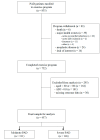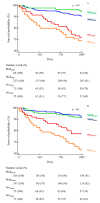Rehabilitative Exercise Reduced the Impact of Peripheral Artery Disease on Vascular Outcomes in Elderly Patients with Claudication: A Three-Year Single Center Retrospective Study
- PMID: 30736443
- PMCID: PMC6406499
- DOI: 10.3390/jcm8020210
Rehabilitative Exercise Reduced the Impact of Peripheral Artery Disease on Vascular Outcomes in Elderly Patients with Claudication: A Three-Year Single Center Retrospective Study
Abstract
The study retrospectively evaluated the association between rehabilitative outcomes and risk of peripheral revascularizations in elderly peripheral artery disease (PAD) patients with claudication. Eight-hundred thirty-five patients were enrolled. Ankle-brachial index (ABI) and maximal walking speed (Smax) were measured at baseline and at discharge from a structured home-based rehabilitation program. For the analysis, patients were divided according to a baseline ABI value (severe: ≤0.5; moderate: ≥0.5) and according to hemodynamic or functional rehabilitative response (responder: ABI ≥0.10 and/or Smax >0.5 km/h). Three-year outcomes were collected from the regional registry. According to the inclusion criteria (age 60⁻80, ABI <0.80; program completion) 457 patients, 146 severe and 311 moderate, were studied. The whole population showed significant functional and hemodynamic improvements at discharge, with 56 revascularizations and 69 deaths at follow-up. Compared to the moderate group, the severe group showed a higher rate of revascularizations (17% vs. 10%, p < 0.001) and deaths (29% and 8%, respectively; p < 0.001). However, patients with severe PAD who were ABI responders after rehabilitation showed less revascularizations than non-responders (13% vs. 21%; hazard ratio (HR): 0.52) and were not different from patients with moderate disease (9%). Superimposable rates were observed for Smax responders (13% vs. 21%; HR: 0.55; moderate 10%). In conclusion, elderly patients with severe PAD empowered by better rehabilitation outcomes showed lower rates of peripheral revascularizations and deaths that were comparable to patients with moderate PAD.
Keywords: exercise; mortality; peripheral artery disease; rehabilitation; vascular surgical procedures.
Conflict of interest statement
The authors declare no conflict of interest.
Figures




Similar articles
-
Changes in exercise capacity and risk of all-cause mortality in patients with peripheral artery disease: a 10-year retrospective cohort study.Intern Emerg Med. 2020 Mar;15(2):289-298. doi: 10.1007/s11739-019-02176-3. Epub 2019 Aug 21. Intern Emerg Med. 2020. PMID: 31435898
-
Gender Differences in Outcomes Following a Pain-Free, Home-Based Exercise Program for Claudication.J Womens Health (Larchmt). 2019 Sep;28(9):1313-1321. doi: 10.1089/jwh.2018.7113. Epub 2018 Sep 15. J Womens Health (Larchmt). 2019. PMID: 30222507 Free PMC article.
-
Home-based exercise for elderly patients with intermittent claudication limited by osteoarticular disorders - feasibility and effectiveness of a low-intensity programme.Vasa. 2018 Apr;47(3):227-234. doi: 10.1024/0301-1526/a000692. Epub 2018 Feb 21. Vasa. 2018. PMID: 29463192
-
Effect of ramipril on walking times and quality of life among patients with peripheral artery disease and intermittent claudication: a randomized controlled trial. Journal of the American Medical Association 2013; 309: 453-460.Vasc Med. 2013 Aug;18(4):234-6. doi: 10.1177/1358863X13497529. Epub 2013 Jul 18. Vasc Med. 2013. PMID: 23867841
-
Associations of exercise ankle-brachial index, pain-free walking distance and maximum walking distance with the Peripheral Artery Questionnaire: Finding from the PORTRAIT PAD Registry.Vasc Med. 2019 Feb;24(1):32-40. doi: 10.1177/1358863X18785026. Epub 2018 Jul 11. Vasc Med. 2019. PMID: 29992849
Cited by
-
Biomarker Utility for Peripheral Artery Disease Diagnosis in Real Clinical Practice: A Prospective Study.Diagnostics (Basel). 2020 Sep 20;10(9):723. doi: 10.3390/diagnostics10090723. Diagnostics (Basel). 2020. PMID: 32962217 Free PMC article.
-
To Treat or not to Treat? The Fate of Patients with Intermittent Claudication Following Different Therapeutic Options.Rev Cardiovasc Med. 2024 Jun 24;25(6):229. doi: 10.31083/j.rcm2506229. eCollection 2024 Jun. Rev Cardiovasc Med. 2024. PMID: 39076305 Free PMC article.
-
Home-Based Exercise in Elderly Patients with Claudication and Chronic Kidney Disease Is Associated with Lower Progressive Renal Function Worsening: A 5-Year Retrospective Study.Metabolites. 2022 Dec 30;13(1):56. doi: 10.3390/metabo13010056. Metabolites. 2022. PMID: 36676981 Free PMC article.
-
Biomarkers of Muscle Metabolism in Peripheral Artery Disease: A Dynamic NIRS-Assisted Study to Detect Adaptations Following Revascularization and Exercise Training.Diagnostics (Basel). 2020 May 16;10(5):312. doi: 10.3390/diagnostics10050312. Diagnostics (Basel). 2020. PMID: 32429406 Free PMC article.
-
Lower All-Cause Mortality Risk in Females and Males with Peripheral Artery Disease following Pain-Free Home-Based Exercise: A 7-Year Observational Study.J Pers Med. 2023 Apr 5;13(4):636. doi: 10.3390/jpm13040636. J Pers Med. 2023. PMID: 37109022 Free PMC article.
References
-
- Writing Committee Members. Gerhard-Herman M.D., Gornik H.L., Barrett C., Barshes N.R., Corriere M.A., Drachman D.E., Fleisher L.A., Fowkes F.G.R., Hamburg N.M., et al. 2016 AHA/ACC Guideline on the Management of Patients with Lower Extremity Peripheral Artery Disease: Executive Summary. Vasc. Med. 2017;22:NP1–NP43. doi: 10.1016/j.jacc.2016.11.008. - DOI - PubMed

